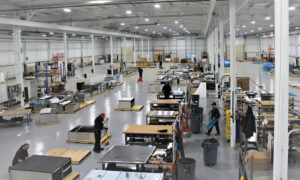Surgeon General issues report that shows poor working conditions correlate with physical health problems like cancer, heart disease, depression and anxiety
By Deborah Jeanne Sergeant
“Toxic” work environments describe places that are not just unpleasant but are actually harmful — and not necessarily in the way that OSHA can do something about.
“A toxic workplace is one where the employees are constantly in a state of stress and anxiety,” according to The Leadership Reformation. “This can be due to any number of factors, such as unrealistic deadlines, impossible workloads or simply a toxic culture where backstabbing and office politics are the norm. In a toxic workplace, employees are often afraid to speak up or voice their opinions for fear of retaliation. As a result, they may start to experience physical and mental health problems.
“In contrast, a bad work environment is simply one that’s unproductive or unpleasant. This could be due to things like sub par working conditions, nonexistent or ineffective management, or just a general feeling of dissatisfaction among employees. While a bad work environment can certainly lead to stress and anxiety, it doesn’t have the same level of toxicity as a toxic workplace.”
US Surgeon General Vivek Murthy released a statement in October that shows poor working conditions correlate with physical health problems like cancer, heart disease, depression and anxiety.
“Workplace mental health and wellbeing is a critical priority for public health,” Murthy wrote. “It has numerous and cascading impacts for the health of individual workers and their families, organizational productivity, the bottom-line for businesses and the US economy.”
Physician Leslie J. Kohman, SUNY distinguished service professor of surgery, was appointed in 2020 as chief wellness officer at University Hospital, and wellbeing and mental health resources at SUNY Upstate Medical University. She said Upstate developed her position over the course of two years to further improve the work environment.
“In healthcare, burnout and high stress among workers started long before the pandemic,” Kohman said. “The pandemic was the straw on the camel’s back.”
The nationwide burnout among healthcare providers has contributed to further staffing shortages that have been ongoing for numerous years. Staffing shortages have been listed by more than two-thirds of Upstate staff as contributing to their feelings of burnout.
Understaffing also contributes to workplace violence as patients must wait longer for services. Kohman said that patient and family member attacks on staff — both verbal and physical — have become “epidemic” nationwide. Some of the issue has to do with behavioral health patients who have no other place to go. People become impatient waiting in the emergency room for admission to beds unavailable because the health care system as a whole, including group homes and skilled nursing facilities, lacks staff to care for the patients.
“We are slowly, slowly lowering the turnover rates among nurses and we’ve re-opened most of the beds closed due to short staffing during the pandemic,” Kohman said.
In order to balance quality of care for patients and quality of life for employees, staff members have been asked to stay beyond their shifts and may not be able to take vacation when they choose. Upstate has launched support programs, including one with trained peers from other hospitals, so Upstate employees can maintain confidentiality. Upstate has more than 100 peer supporters, who are trained in reflective listening skills to support their peers in distress.
Another example is the Community Building at Upstate. A grant from the All in Fund supports a program where six or eight medical staff members get together monthly for a subsidized meal to talk and commiserate about workplace issues.
Upstate also plans to launch virtual reality break stations to allow employees to virtually spend quiet time at a beach, waterfall or other peaceful venue they can select from a menu.
Upstate also has “Pet a Pooch” visits from therapy dogs for employees monthly. The Pathway to Wellness program also has many events to boost resilience, such as walking trails around the campus and online sessions for 15 minutes of chair yoga.
“We are working on programs to address hotspots,” Kohman said. “If there is a unit or team that has experienced some kind of distress, we want to have a trained person go there and assist that group with managing their distress. We have hired a social worker who is only for the staff. We’ve also just brought on an evening chaplain who will work from 4 to 11 p.m. Half of her job description is to support staff.”
Kohman expressed pride in Upstate’s employees’ camaraderie in helping each other out during the recent tough times. But sometimes, going above and beyond to cover others’ shifts or duties can negatively affect employees’ own health and well-being.
“The issue is the infrastructure on a nationwide basis has not been there to support their wellbeing,” she said.
Although public patience with healthcare seems to be threadbare, “what we all have to do is just be compassionate and be very patient, acknowledging that we’re doing the best we can and hiring as fast as we can,” Kohman said. “If they don’t treat workers with respect, more will quit.”
At Syracuse Orthopedic Specialists in East Syracuse, Cheryl Holdrege, human resources director, said strengthening the workplace culture represents a big emphasis recently, including forming a diversity, equity and inclusion committee “so our patients walking through the front door look like them. You relate more to someone who looks like you.”
The committee also focuses on compassion, accountability, respect, excellence and service to patients and with one another. SOS brings in outside speakers to discuss aspects of maintaining good health such as nutrition and emotional wellness.
In September, SOS launched its SOS Cares cards program where employees receive companywide recognition for examples of caring to normalize it.
The SOS program represents an example of the shift in human resources away from stick towards that of the carrot. Instead of only punishing unwanted behavior, companies work on rewarding good behavior.
Naturally, employees’ different personalities don’t always see eye to eye. Nontoxic companies cannot and would not want to make each worker emotionless automatons. However, fostering an environment where different personalities are respected and celebrated generates esprit de corps.
“It’s about being positive and realizing that people have their own beliefs. It’s about being respectful,” she said. “But even if they’re not on board, we have to respect that there will be differences though we’re still going to do it.”
Holdrege believes that one of the things SOS is doing well is striving for a working environment where all employees are working together towards the goal of helping patients get better. This takes improving listening skills and avoiding reactionary responses.
“We’ve had to have people take a step back and listen to what people have said,” Holdrege said. “It’s active listening versus reactionary listening.”
This helps develop mutual respect among employees. SOS employs 723 among its nine physical locations and two surgery centers.
In addition to improved communication, SOS encourages fun to help with bonding, such as a dress-up party for Halloween and wellness events that encourage employees to get to know each other.
“We make sure we smile every day and have fun with each other,” Holdrege said.




